Pocket watches in Victorian and Edwardian times
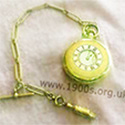
Pocket watches, as their name implies, were designed to be kept inside pockets, usually but not necessarily on a chain firmly attached to a specially designed hole in a waistcoat of some sort. This page elaborates on the watches themselves, how they were set and wound and how they served as status symbols. Gender issues are also considered in connection with these watches.
____
By the webmaster based on childhood observations, discussions with older people and further research
My recollections start with the 1940s. However, discussions with older people indicate that this page would apply many years previously.
What pocket watches were and how they were used
Before the digital era, watches were analogue and very expensive in real terms because they had small workings which were made individually. So pocket watches were were specially designed to be kept in pockets for safety. Hence their name. For security reasons they were normally kept on chains which slotted through specially made holes in waistcoats. These holes were edged like button holes but were round - although it was not unknown for existing button holes to be used, as shown on many of today's modelling websites. The holes never bore the weight of the watch - that was borne by the pocket. It was merely a safety measure if the pocket tore or someone tried to pickpocket the watch.
The chain was kept from falling out of the hole by means of a fob on the end of the chain that slotted through the hole and rested on the body side of the waistcoat. The fob often had something small and attractive which would hang on the visible side of the waistcoat. This is most clearly seen in the first of the following images.
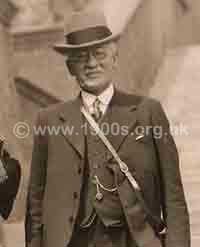
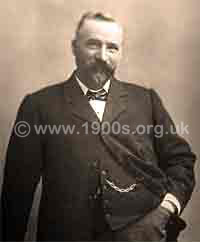
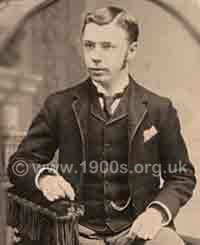
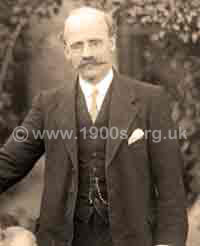
Family members of the past displaying the chain of their pocket watches
Winding a pre-digital watch
Pocket watches, like all pre-battery watches, had to be wound using a winder on the outside of the case. This tightened a spring which powered the watch as it unwound. When completely unwound, the watch stopped.
This winder was inside the ring from which the watch hung.
The winder of a pre-digital watch: visible or hidden
contributed by Douglas Adam
In normal use, the winder-stem of a watch is not visible, but the winder knob can be pulled out slightly to show the stem and enable winding.
Winding up
The spring needs to be wound in clockwise rotation. But for convenience, so as to avoid changing grip, anti-clockwise normally just clicks a ratchet but does nothing else. A back and forth repeated action by rubbing the winder backwards and forwards eventually meets resistance showing that the spring is fully wound. Overwinding breaks the spring so that the spring no longer works.
Setting the time
Pulling the winder out, causing the watch stem to show more, engages the hands, clockwise advancing time and anti-clockwise reversing.
I was always told that the watch hands must only be advanced in a clockwise direction because winding anti-clockwise either damages the mechanism or meets resistance. This is no longer the case for setting the time on modern clocks.
Pocket watches as status symbols
Pocket watches were expensive and the photos show men seemingly make a point of displaying them. Owning a pocket watch was clearly important and indicated that the wearer was proud of his status. As far as I know, no watches were ever worn on wrist straps until later in the century.
Whereas owning a pocket watch was a status symbol, the type and style of the chain could enhance status still more. Many chains were relatively thin and made of a base metal, but heavy gold was what wealthy men aspired to.
In the second of the above pictures, the man is apparently nonchalantly putting his hand is his pocket, but actually not so nonchalantly as it lets him show a heavy chain which is probably gold and a waistcoat with a custom-made round hole.
Gender inequality and owning watches in the early 20th century
It will not have escaped your notice that the pocket watches in the photos are all worn by men - an indication of the accepted gender inequality of the late 19th and early 20th century. Owning a watch seemed to be almost entirely a male prerogative.
Wealthier women and pocket watches
My grandmothers were born around 1880 and they came from very different social backgrounds.
The pocket watch in the following photo belonged to my grandmother from the somewhat better off background. It is smaller than a man's pocket watch with a shorter chain, but otherwise its main parts are identical to those of men's pocket watches. I would love to know how she wore it. She was killed in the Second World War blitz so I never had the chance to ask her.
The chain is made of gold with each of the long links hallmarked. On the far left is the longish, narrow part that was fed into the hole of some sort of jacket. It would have been invisible in use as it would rest on the body side the jacket. The fob is a gold sovereign. Clearly a status symbol in its own right.
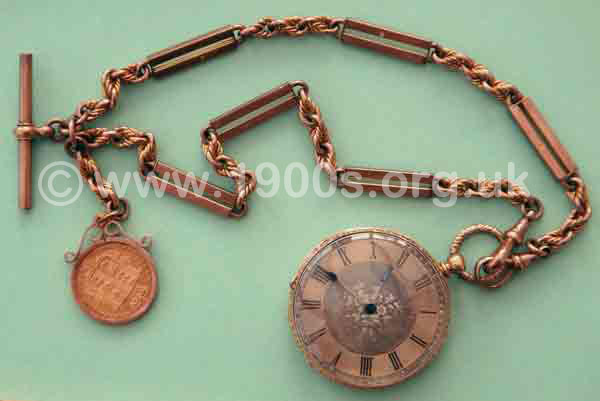
Woman's gold pocket watch in the wider family. The fob is on the far left and the sovereign dated 1885 is just a decoration. The narrow bar on the far left of the photo is what goes inside the jacket hole to hold the watch securely.
Working class women and telling the time
My other grandmother never owned a watch and there was probably not even a clock in her house while she was raising her young children in the early 1900s. In later life she mentioned that when she wanted to know the time, she used to go out of the front door to read the clock on the tower of the local church. This was some considerable distance away.
My mother, her daughter, would recount tales from her early 1900s childhood when her own grandmother would send her on errands, just to find out the time.
Styles of pocket watch: Hunter and Half-hunter
The watch in the picture does not have a solid protective case over the glass of the watch face, but it was common for watches to have some sort of hinged case.
Hunter pocket watches
Where the case covered the watch face, the watch was called a Hunter Watch. The user had to press a knob to snap the case open in order to read the time.
Half hunter pocket watches
A Half Hunter pocket watch had a case with a glass central portion which protected the watch while allowing the user to read the time without having to open the case. Often cases were beautifully engraved.
The picture at the top of this page is a Half-Hunter.
There were all sorts of variations. I was told of a Hunter watch that had a figure pop up when the case was opened.
| sources | webmaster | contact |
Text and images are copyright
If you can add anything to this page or provide a photo, please contact me.



